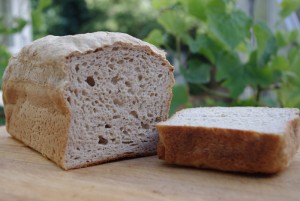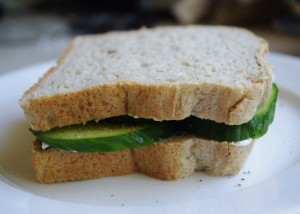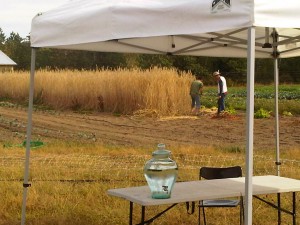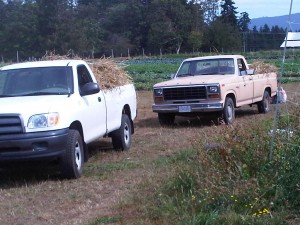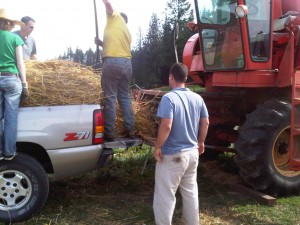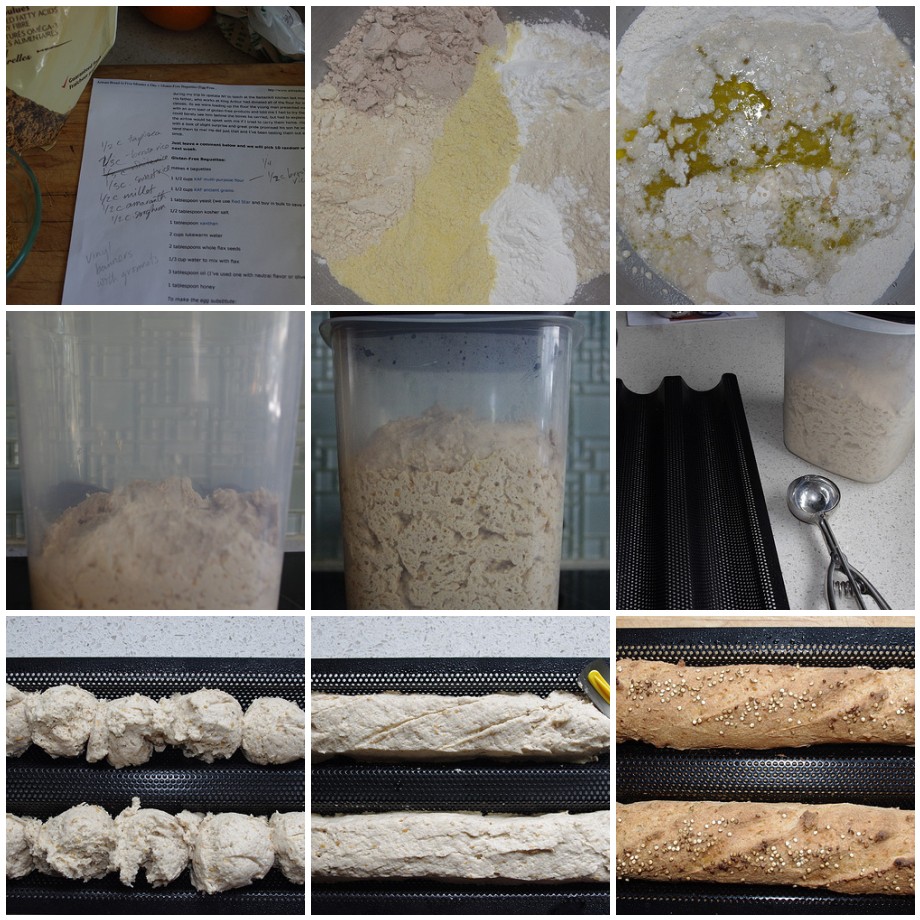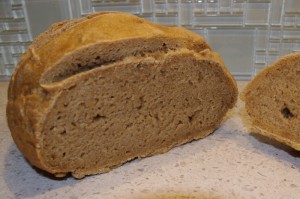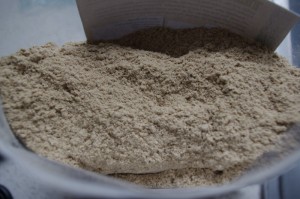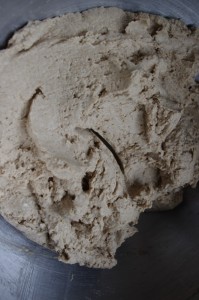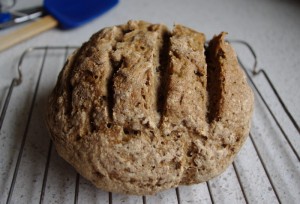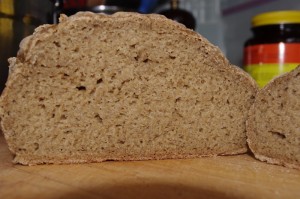So I’m starting by sharing some of the non-sourdough experimenting I’ve been doing with this flour blend that Dr. Jean Layton has come up with for her sourdough feeder. As she mentions in her post, [...]]]>
So I’m starting by sharing some of the non-sourdough experimenting I’ve been doing with this flour blend that Dr. Jean Layton has come up with for her sourdough feeder. As she mentions in her post, she was aiming for something that was close in composition to hard white winter wheat — a wonder grain when it comes to bread baking with long ferments.
So I’m sharing a few things as we go…I’ve been playing around with this flour blend, both with regular baking and as a sourdough, to see what kind of properties it had, and whether it was versatile enough for some other applications like bagels, which also normally rely on the unique properties of high-protein bread flours.
This first loaf is not, in fact, a sourdough, but just a regular loaf which I had hoped to make both dairy-free and egg-free. I was also aiming for structure that was pleasant and springy, and would have good shelf-life, and retain lots of bounce and moisture, so that it could be eaten without toasting. As many of you know, gluten-free breads, by the nature of the ingredients, tend to lose that elasticity quite quickly, and in applications such as bread puddings, absorb moisture from the inside-out.
I’ve been pleasantly surprised by this loaf — Its been sitting on the counter now for two days, and each day, I’ve been able to slice it and make a sandwich with it, without having to toast the bread first!!! The loaf is crusty on the outside the day of baking, but after being in a ziploc bag, the crust becomes tender and springy also. The combination of the flour, plus the addition of the chia seeds really seems to be working some gluten-free magic here!
Bread #1 with Dr. Jean Layton’s flour blend
- 200 grams Dr. Jean Layton’s sourdough flour blend
- 50 grams tapioca starch
- 50 grams cornstarch
- 1 1/4 teaspoon xantham gum
- 1 teaspoon guar gum
- 3/4 teaspoon sea salt
- 2 1/2 teaspoons yeast
Mix all dry ingredients together in a medium bowl, whisking to combine very well
- 2 Tablespoons chia seed, ground in a coffee grinder
- 1/2 cup lukewarm water
Mix the chia seed with the water in the bowl of a stand mixer (mix well). Let sit for 15 minutes until it forms a gel. Add:
- 1 Tablespoon honey
- 1 1/4 cup lukewarm water
Mix wet ingredients well, Add the dry ingredients and mix with the paddle attachment on medium speed for at least 3 minutes. Grease an 8 1/2 X 4 1/2 loaf pan, and transfer the bread dough (it will look like thick cake batter), to the loaf pan. Smooth out the top, and cover with a damp towel or plastic wrap. Let the dough rise for 30 minutes.
While the dough is rising, preheat the oven to 400 degrees F (use an oven thermometer to make sure your oven is calibrated!).
After rising, bake the loaf at 400 degrees for 35-45 minutes, until the interior registers 205 degrees F.
Stay tuned for more baking with this flour! I see chewy bagels in our future, as well as lots of sourdough bread!!!
As always, this is made with yeast, so we’re sending a link over to Yeastspotting! Go check out all the amazing bread bakers out in the blogosphere!
]]>We always associate grain-growing with prairie farming, but, in fact, grain has been grown successfully on Vancouver Island in days gone by, and one of the interesting things about landrace varieties such as Red Fife, is that they are quite adaptable, and develop flavours and characteristics unique to the region growing them. We also don`t see a lot of organically grown whole grains such as rye, and I was also curious to see how a hardier grain would fare in our climate.
My share of the harvest was roughly to 875 square feet of growing space, some of which was devoted to Red Fife Wheat, some to Hard White Spring Wheat, and some to Rye. Heather and Brock also organized the Threshing through another Cowichan Valley farmer with a small combine, and have plans for one more workshop on cooking with whole grains.
Harvest day actually ended up being delayed by a week — with all the funny weather we’ve been having through the summer, the grain needed another week to fully dry. Sunday, I woke up to sunny weather, and headed up island, with a thermos of coffee, lots of water, and a packed lunch!
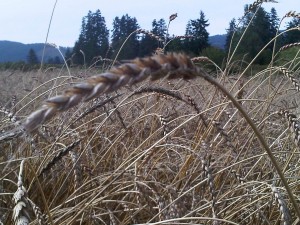 Brock and Heather had planted three grains this year — some of which had been planted last fall, and some of which were planted in the spring. It was interesting to see the differences between the same varieties planted at different times of the year. Many of the grains are quite happy being fall-planted, and there was a marked difference in the rye which Brock had not only planted in the fall, but interspersed with fava beans!
Brock and Heather had planted three grains this year — some of which had been planted last fall, and some of which were planted in the spring. It was interesting to see the differences between the same varieties planted at different times of the year. Many of the grains are quite happy being fall-planted, and there was a marked difference in the rye which Brock had not only planted in the fall, but interspersed with fava beans!
The Red Fife wheat is a heritage variety, which, while good for baking (excellent flavour and protein content), runs the risk of lodging (falling over). The stalks are decidedly more slender. For the drawbacks though, for those planting and harvesting on a smaller scale, this was much easier to load into the trucks, compacted more easily, and did not have much in the way of prickly awns.
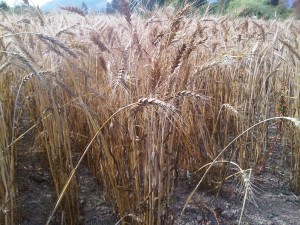 The Hard White Spring wheat, on the other hand, is much more compact, with sturdy stems and lots of protection from marauding fauna due to the awns. While it cut very easily, it took a great deal more effort to pack the trucks for their trip to the combine, and I`m still picking prickly bits of awns out of my underwear!!!!
The Hard White Spring wheat, on the other hand, is much more compact, with sturdy stems and lots of protection from marauding fauna due to the awns. While it cut very easily, it took a great deal more effort to pack the trucks for their trip to the combine, and I`m still picking prickly bits of awns out of my underwear!!!!
Finally, the Rye turned out to be very prolific. Some of the seedheads were a full 4-5 inches long!!! The stems of the rye that Brock planted with the fava beans were easily 6 feet tall, and actually got harvested by the Cowichan Valley Ecovillage to use as thatching for some of their demonstration buildings. These guys were harvesting fairly carefully, creating nice neat bundles as they went. Despite being so tall the stems were remarkably sturdy, showing little sign of toppling over. The rye (similar to barley), also has a built-in indicator of ripeness, where the seed-head nods so its parallel with the stem, curling right back on itself as it dries.
During the course of the day, we harvested all of the grain by hand — a combination of scythe, sickle and shears — creating piles as we went. The harvest went fairly quickly, and was loaded into the waiting trucks in batches (to keep each grain separate) to be taken off to the combine. It is possible to thresh by hand, but the combine was MUCH faster!
At the combine, the grain got fed into the combine with a fork — through the rotating drum, with the straw coming out the back end. A couple of people at the back end were needed to feed the straw into the baling machine, which resulted in a good number of bales of organic straw for Heather and Brock to use in the fields.
Finally, the grain, once threshed, was collected in plastic bins — you can see Brock, hoisted up near the chute, making sure the rye actually got into the bins!
All told, we had 12-15 folks helping throughout the day — most of whom, like me, were inexperienced at this kind of thing. Total harvest, about 900 lbs of grain, with a bit left on the ground to fatten up the chickens!
For my share, I now have 10 lbs Red Fife, 10 lbs Hard White Spring wheat and 20 lbs Rye. I`ll be making bread with some, using some as whole grain (wheat or rye berries), and perhaps saving a little for seed for next year. I`m already looking forward to next year!
]]>I’ve been playing around with the gluten-free recipes from Healthy Bread in 5 Minutes per day. Zoe Francois and Jeff Hertzberg have done a great job of providing whole grain and gluten-free options for their Artisan Bread in 5 minutes per day method.
Simply put, this method is great for families and households where you would like [...]]]>
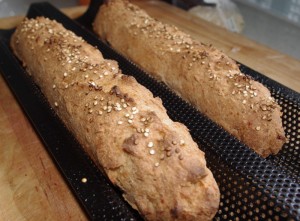
I’ve been playing around with the gluten-free recipes from Healthy Bread in 5 Minutes per day. Zoe Francois and Jeff Hertzberg have done a great job of providing whole grain and gluten-free options for their Artisan Bread in 5 minutes per day method.
Simply put, this method is great for families and households where you would like to be able to make bread with a minimum of fuss. It involves mixing larger batches of dough, and letting a long, cool, delayed fermentation do the rest of the work for you. For wheat-based breads, this method is great, as it develops the gluten structure slowly, but thoroughly, and has the added benefit of the enzymatic reactions typical of a delayed ferment. Obviously, with gluten-free breads, there is no need to develop the gluten, but this method is a great one nonetheless, for the convenience AND for the flavour development
While I’ve been doing my own noodling around with these recipes to make them egg and dairy-free, a while back, I noticed that ABin5 put up their own version of an egg-free, gluten-free version, which was also whole-grain heavy to boot! AWESOME, I thought, and read on, only to discover that it made use of some of the new King Arthur gluten-free flours — not at all readily available to us up here in B.C. In my trials with this method, I’ve moved completely away from commercial egg-replacers as I found them too drying, and been relying on chia seeds or flax seeds, so I was interested to see that ABin5 also fell back on flax seeds for theirs.
Undaunted, I set about to play around and come up with a recipe that would be heavier on whole grains, but be feasible for those of us still buying our flours separately! This is my modification of Zoe and Jeffs — the proportions are based on their original recipe, with the major change being the flours. This relies on only about 25% starch for the texture: considerably less than the minimum of 50% that many other gluten-free breads require to achieve a pleasant texture. The other addition here that is critical, is the inclusion of sweet rice flour, which adds moisture and helps with the binding of the final flour.
A final note: I’ve given proportions in volume measures here. There is minimal mixing required for this approach, as the xantham gum hydrates slowly while the dough sits, and I’ve found that hydration levels are easy to adjust for as you go. I’ve tried both volume and weight measures, and had consistent results with both, so left the measures as volumes as many folks find them easier.
We’re making baguettes here today, but stay tuned to see what else we can make with this dough! We’re also sending this one over to Yeastspotting, go check out what some amazing bread bakers have been up to!!!
Whole “Grain” Gluten-free, Egg-free Baguettes
(modified from Artisan Bread in 5 minutes per day)
- 2 tablespoons flax meal (I use golden flax seeds for their flavour)
- 1/3 cup warm water
- 1/2 cup tapioca starch
- 2/3 cup brown rice flour (make sure to use one that is very finely ground, not gritty)
- 1/3 cup sweet rice flour (also called “glutinous rice” or “sticky rice”)
- 1/2 cup millet flour
- 1/2 cup amaranth flour
- 1/2 cup sorghum flour
- 1 Tablespoon instant yeast
- 1 1/2 teaspoons sea salt
- 1 Tablespoon Xantham gum
- 2 cups warm water
- 3 Tablespoons olive oil
- 1 Tablespoon honey or organic cane sugar
Mix together the flax meal and 1/3 cup water and set aside for 15 minutes until it becomes thick and gloppy.
In a large bowl, mix together flours, yeast, salt, and xantham gum. Whisk well to combine all the ingredients (You do NOT want to have blobs of xantham gum!!!)
Add all the liquid ingredients to the dry ingredients and mix with a spatula until the dough is well mixed. Transfer the dough to a container with a loose fitting lid, and let rise for 1 1/2 – 2 hours until doubled in volume. The dough will be airier in texture than wheat-based dough. Store the dough in the refrigerator for up to 1 week.
To bake baguettes, preheat the oven to 450 degrees. Grease a baguette pan, or line with parchment paper. (You can do this on a heavy sheet pan, but the baguette pan allows for greater air circulation on all sides of the baguette — its all about the crusty exterior!!!)
To shape this dough, you want to handle it as little as possible. I’ve found the easiest way to form into baguettes is with a scoop, laying scoops of dough all in a row and then use a wet spatula or fingers to smooth out the scoops into a uniform baguette. Sprinkle seeds or gluten-free grains of your choice on top of the baguettes. Once you’ve formed the baguette, let it sit for about 30 minutes, to take the chill off the dough. It won’t double in size, but will have oven spring once it starts baking. You can also slash the top of the dough to control the rise, just be gentle when you do!
Bake at 450 degrees for 30-35 minutes. Let the baguettes cool completely before you try to cut them!
]]>My first attempts used Ener-g egg [...]]]>
My first attempts used Ener-g egg replacer, which worked fine for the loaves baked immediately, but did not perform so well when the dough was stored (which is the whole point of ABin5!).
I was also interested in finding a way of using the Timtana flour, as I really like the way it performs in yeast-raised breads, so after a bit more dabbling, here`s what I`ve come up with.
This is a dense loaf, as it contains a fairly high whole grain/starch ratio. With the delayed fermentation, this bread has a nice, slightly sour taste, and a very crusty exterior. The addition of the timtana flour, helps the bread remain moist and pliable for a few days after baking (as well as being pretty darn tasty!)
This recipe is adapted from Healthy Bread in 5 Minutes per day to use the Timtana flour, as well as be egg-free. For those who don’t have timtana flour, an equally tasty variation on the loaf can be made with teff and light buckwheat flour.
Printer friendly recipe: Timtana Artisan Bread
]]>Gluten-free Artisan Style Timtana Bread
Combine dry ingredients in a bowl and whisk well to mix.
- 2 cups (316 grams) brown rice flour (or sub 240 grams light buckwheat flour)
- 1 1/2 cups (180 grams) Timtana flour (or sub 180 grams Teff flour)
- 1 1/2 cups tapioca starch (180 grams)
- 1 1/2 cups potato starch (288 grams)
- 2 Tablespoons xantham gum
- 2 teaspoons agar powder
- 2 teaspoons salt
- 2 Tablespoons instant yeast
Add liquid ingredients to the bowl of a mixer, then add the dry ingredients and mix well with the paddle attachment and mix until the dough smooths out, about 2 minutes.
- 2 2/3 cup water at room temperature
- 1/3 cup grapeseed oil
- 2 Tablespoons light agave syrup or cane sugar
Cover and allow the dough to sit at room temperature for 90—120 minutes, until risen. If you use immediately, take about 700 grams and shape into a smooth ball on parchment. Allow the dough to rest for 30-40 minutes while the oven preheats to 400 degrees. Slash the top just before baking. Bake (with steam) for 45-50 minutes.
Refrigerate the remaining dough. Let the cold dough sit for 90 minutes after shaping.
Dough will keep in the refrigerator for up to 7 days.
The Timtana flour comes from the seeds of [...]]]>
The Timtana flour comes from the seeds of Timothy grass (basically a perennial forage grass). What is interesting, is that it is grown as a perennial, rather than continuous annual cropping like most other grains. Its also packed with protein and nutrients. Looking at the properties of it, I had some ideas in mind, thinking it might behave much like teff flour in baking. Nutrient content as outlined on the bag:
120 grams = 1 cup flour
nutrition facts per 1/4 cup flour:
- 90 calories
- 2 grams fat (0 saturated, 0 transfat)
- nil cholesterol
- 0 mg sodium
- 19 gram carbohydrate (5 grams dietary fibre)
- 1 gram sugar
- 5 grams protein
- This stuff also contains Calcium and Iron!
The flour is completely gluten-free, processed in the Montana Processors facilities with no risk of cross-contamination. Not only that, but the Timothy grass is also grown in fields that have not had any glutinous crops grown on them within a four-year period. Hard-core attention to detail!!!
So this morning, I opened the bag of flour up, and was somewhat surprised! Right out of the bag, the flour is much fluffier than most other gluten-free flours, which tend to fall either in the starch or the fine-sandy camps. The flour itself is a little bit nutty in flavour, with a sweet, slightly grassy aroma to it, and a light brown colour.
So for the first round, I figured I would go pretty basic, with bread. Not too many other flavours as I really wanted to get a sense of not only how this baked up, but also whether the flavours would change much on cooking. I’ve been thumbing through the new Healthy Bread in Five Minutes a Day, and opted to try out a modified and veganized version of the basic gluten-free boule. I’ve made this gluten-free bread before, with millet flour, and wanted to see if the Timtana flour would provide much loft and whether it would develop a crust.
I mixed up this batch of dough by hand and it wasn’t difficult. When you make the dough this way, it is quite a bit more dough-like than many other gluten-free bread “doughs”, but it remained fairly soft throughout. After letting it rest for about 2 hrs, I split it in half, to bake part of it, and stash the other half in the fridge to see what it will be like tomorrow. For those of you who haven’t tried the Artisan Bread in Five Minutes a Day (and you can do a gluten-free version!), you mix up a large batch of dough, let it go through an initial proof, and then store it in the fridge for 1-2 weeks, pulling of a loaf-sized amount as you need it. It really does work, so we’ll see what happens with this batch with the Timtana flour.
So here’s the bread fresh out the oven — a small boule perfect for 3-4 people with dinner. I baked this at 450 degrees, under cover for 15 minutes, and uncovered for 20-25 minutes. The texture of the inside is quite nice — hearty but not too dense. The Timtana bakes up with a nice crust, which is also aided a bit with the cornstarch I added to the initial flour mix.
The interior is fairly moist (made very few additions to this to encourage the moisture). The crust is chewy, with a soft interior crumb, which I thought had a faint alfafa aroma. Where the dough was browned, the flavour is much more nutty. All in all, a pleasant loaf of bread — Jeff gave this a thumbs up. I am thinking for the next round I may add a little bit of almond meal or flax meal.
I’m thinking this dough would also make tasty bagels — holding their shape well with a nice crust on the outside.
Basic Timtana Bread (adapted from Healthy Bread in Five Minutes a Day)
- 1 3/4 cup Timtana flour (210 grams)
- 3/4 cup tapioca starch (112 grams)
- 3/4 cup cornstarch (96 grams)
- 1 Tablespoon instant yeast
- 1 1/2 teaspoons salt
- 1 Tablespoon xantham gum
- 1 Tablespoon Ener-g egg replacer whisked with 4 Tablespoons water until very foamy
- 1 1/3 cup water
- 2 Tablespoons grapeseed oil
- 1 Tablespoon evaporated cane juiuce
Whisk dry ingredients together until well combined. Whisk wet ingredients together, and add dry ingredients, stirring well until the dough starts to smooth out. Cover and let the dough rest at room temp for 2 hours. Refrigerate for up to 2 weeks if not using immediately. Dough will be best if used by 7-8 days.
To bake, take half and smooth into a loaf or ball on a parchment-lined baking sheet. Preheat oven to 450 degrees. Let the dough rest for 30-40 minutes, and slash the top just before baking. Put the pan in the oven, covering with a disposable lasagna pan for 15 minutes. Remove the foil pan, and continue baking for about 20-25 minutes, until the internal temperature registers 205 degrees. Let cool for at least 45 minutes before slicing.
I also tried the Timtana flour out in Banana bread — post to come as its just come out of the oven but is too hot to slice ![]()
